Introduction
Are you struggling to create a comfortable atmosphere in your coffee shop? Want to attract more customers and increase their stay?
LED screens may be the key you need. They not only display information but also enhance your coffee shop’s atmosphere.
Table of Contents
1. Why is the coffee shop atmosphere so important?
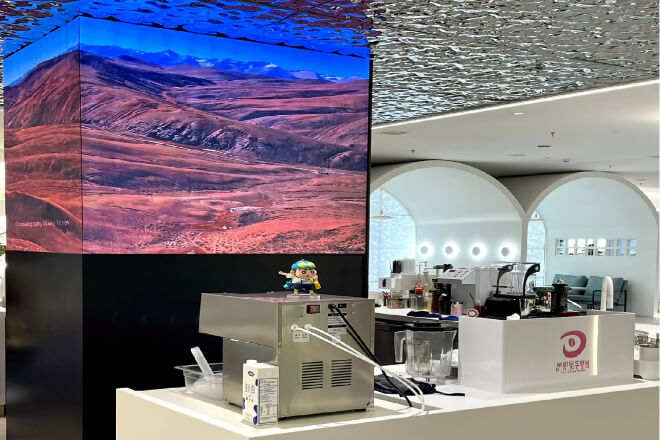
1). Sources of Customer Loyalty
Great coffee is just the beginning of a coffee shop’s reputation. What truly draws people in three times a week is the feeling of relief the moment they step through the door.
The aroma of freshly ground coffee mingles with the sweet aroma of roasted coffee, and the waiter smiles and asks, “Would you like the usual?”—these small details speak louder than any advertisement.
The lighting is just right, not as bright as an operating room, and the chairs are comfortable even after sitting for long periods. The window booths have become a regular spot for regular customers.
If a coffee shop can make customers feel like they can write, watch TV, or just daydream, they will naturally make it a part of their lives, not just a place to buy coffee.
2). First impressions are often determined by visuals.
The few seconds you take upon entering a coffee shop are enough to decide whether or not to stop by.
The warm wooden door frame, the floor-to-ceiling windows bathed in yellow light, and the barista busy preparing latte art behind the bar—these images make the aroma of coffee waft to your nose.
The clean, easy-to-read menu board, coffee bean cans and pour-over kettles displayed in the window tell a story, not just decoration.
The tidy tables, the layered lighting, the bookshelves against the wall, and the few green plants create a sense of missing out.
3). The impact of atmosphere on photography and social media sharing.
A coffee shop’s atmosphere is a natural marketing tool. The moment sunlight filters through the window onto the latte art, or a close-up of the vintage coffee grinder on the bar counter, can easily make customers reach for their phones.
Customers don’t need to pose for photos. Simply place a few small tables near the window, hang a warm wall lamp, and leave a wooden sign or coffee cup sleeve with your shop’s name printed.
Customers will help you post your photos to Instagram, Xiaohongshu, and Twitter.
This kind of sharing is more genuine than paid advertising, because it comes from a moment they spent in your cafe that they felt was worth remembering.
2. What types of shop atmospheres can LED screens create?
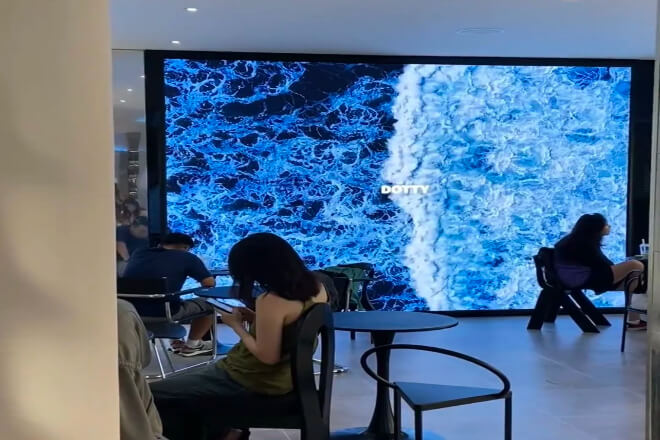
In retro coffee shops, LED screens should be kept low and blended with warm yellow lighting for a comfortable look.
The text on the screen can be displayed in a typewriter-like, slowly popping effect, showcasing today’s hand-poured coffee, a small reminder of the shop, or even a line of poetry.
The slow-moving words and soft lighting make people want to sit down and slowly sip coffee, browse their phone, or even post a check-in on WeChat Moments.
Industrial-style shops often feature concrete walls and exposed pipes, but LED screens can offer a more “hard” feel.
Metallic backgrounds, gears, or geometric lines can gently shimmer and dance with the music, creating a sense of movement.
The screen content can feature short videos about coffee roasting or simple animations, giving the space a sense of rhythm rather than a rigid sign.
Forest-inspired coffee shops emphasise the beauty of wood and greenery. LED screens can display videos of slowly flowing forests, streams, or leaves rustling in the breeze.
Remove the brightness that is too high, and use a slightly soft focus to create the illusion of sipping coffee in a small forest.
Paired with soft music or aromatherapy, customers will feel as if they’re surrounded by nature all afternoon, wanting to put down their phones and simply enjoy the atmosphere.
In modern, minimalist coffee shops, LED screens are more like “quietly telling you information.”
Use a simple white or solid background with clean, crisp text displaying today’s specials or business hours. Avoid excessive animation; gently fade in and out.
The screen should blend seamlessly into the wall, making it barely noticeable to guests. However, information remains readily available when needed, maintaining a clean and refreshing feel.
3. How can content displayed on LED screens avoid becoming overly prominent?
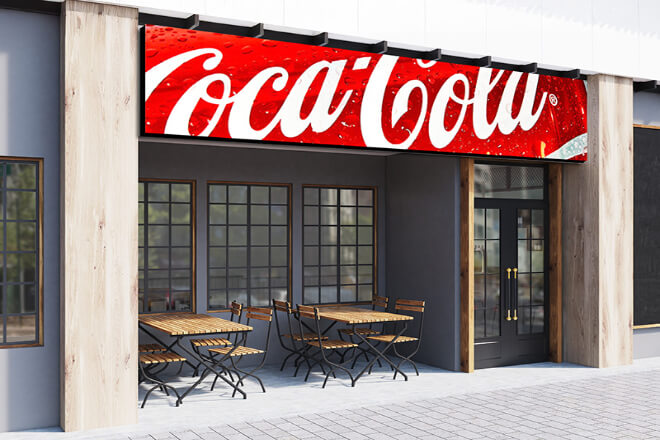
1) Avoid overly commercial content:
A coffee shop’s LED screen isn’t a billboard. Avoid displaying “buy one, get one free” or other promotional messages. Customers come in to relax and enjoy coffee, not be bombarded with marketing.
Display more relatable content: a warm reminder, a short story about the day’s coffee, or a lighthearted, humorous message. These are more likely to attract customers than blunt promotions.
2) Utilise “light content”:
Soft text is the most soothing, such as a handwritten special of the day, a brief sentiment, or a simple sentimental slogan.
The content doesn’t need to be long or full-screen animated; it should feel “interesting and heartwarming” to guests, like a small detail the coffee shop has prepared just for them.
3) Control the Pace:
A dynamic screen is a plus, but don’t let it steal the show from the aroma of coffee and the chatter.
Text and images can scroll slowly, with low frame rates and soft colours. Avoid flashing, creating a relaxing atmosphere.
Customers can see them when they look up, but won’t be distracted when they look down, naturally creating a stable atmosphere.
4. LED screen "atmosphere tasks" at different times of day
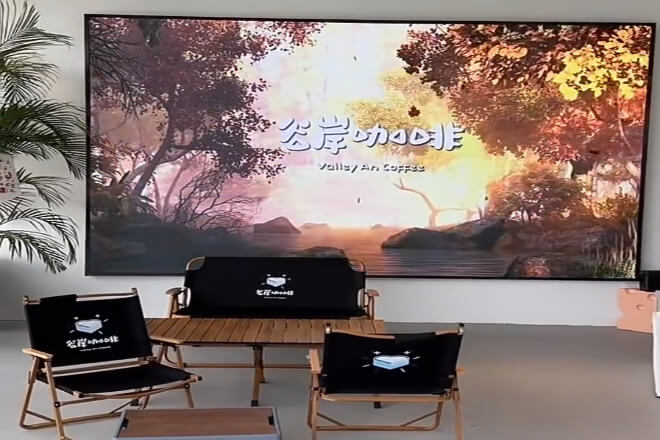
As customers open the door, a cup of hot coffee is just beginning to warm their hands.
The LED screen can display “Today’s Coffee Beans” or a simple weather icon, allowing them to decide which cup of coffee to order while looking at the screen.
Keep the screen light-free; soft tones complement the morning glow, creating a sense of just beginning the day.
After lunch, the shop slows down. The screen can play a soothing background image or motion effects with soft music, while showcasing the day’s dessert recommendations.
Slowly scrolling text and warm colours make customers feel they can slow down time and enjoy a leisurely afternoon break.
The evening light in a café tends to be yellowish, so LED screens can be softened to complement the surroundings.
Use a slowly appearing animated text message like “Goodnight Coffee” or something lighthearted to blend in with the dim light, allowing customers to feel the end of the day and creating a warm yet understated atmosphere.
As closing approaches, the screen can play a slow-paced animation or soft text to remind customers to wrap up, but avoid being too glaring or pushy.
Subtle animations and warm tones are like the café’s gentle message: “Take your time to wrap up today, and come back tomorrow.”
5. How do LED screens complement the lighting and decor?
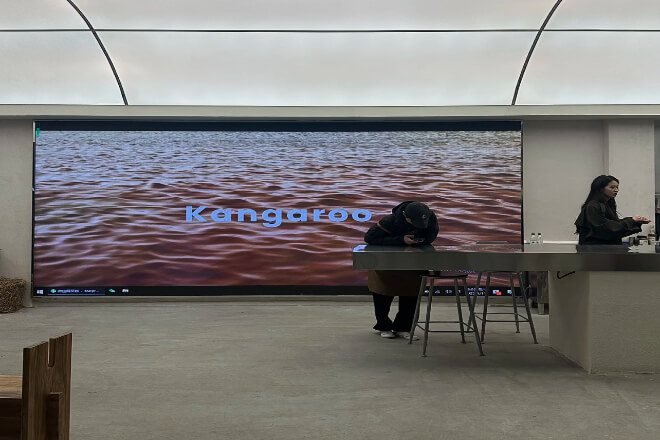
In a café, an LED screen isn’t just a display tool; it’s part of the atmosphere. The brightness of the LED screen must be appropriately coordinated with the lighting.
Too bright will overshadow the aroma of coffee and the soft music, while too dim will make the content difficult to read.
Generally speaking, a screen with a brightness slightly lower than the front lighting is most comfortable, acting as a soft, low-key light within the café.
The screen’s material and frame are also important. While black-framed and mirrored screens offer a modern feel, they can sometimes look out of place in coffee shops with a retro, forest-style, or artistic aesthetic.
Opting for screens with narrow frames, subdued colours, or those invisibly embedded in the wall will make them feel more like a part of the space, rather than a jarring addition.
As for placement, it’s best to design LED screens that follow the lines of the decor, embedding them next to the bar, by the window, or in a corner.
This allows customers to see the information as soon as they look up, without overwhelming the space with the screen.
A harmonious relationship between the screen, lighting, and decor creates a comfortable and natural experience—the information gently floats to the eyes, the aroma of coffee lingers on the nose, and the atmosphere and experience blend seamlessly.
6. Notes: Avoid These Mistakes

Excessively bright LED screens and excessive animations can instantly transform a coffee shop from a comfortable space into a visually stimulating one.
Imagine a customer sitting down to enjoy a pour-over coffee when the screen flashes red, blue, and yellow, instantly interrupting their relaxed mood.
Ideally, maintain a soft colour palette, with animations and text slowly appearing or gently scrolling.
This way, the screen acts like a soft light, conveying information without distracting from the aroma of coffee and soft music.
The screen’s location directly impacts the customer experience. If it’s too low, it may block the tabletop, glaring at guests sitting by the window. If it’s too high or tucked away in a corner, the text or images may be difficult to see.
It’s best to embed it into the bar counter or wall, blending naturally with the interior lines. This way, the screen feels like part of the space, not an obtrusive “billboard.”
This way, whether guests are reading, chatting, or taking photos, their view isn’t interrupted.
If the content on an LED screen isn’t updated for a long time, it will become just a backdrop, losing its original purpose of conveying information and creating atmosphere.
It’s recommended to regularly update the text, images, or small animations, such as a daily introduction to hand-poured coffee beans, today’s dessert recommendations, or heartwarming short quotes or stories.
This way, the screen draws attention to the information and provides a sense of freshness with each visit, increasing customer stay time and their willingness to return.
7. Conclusion
Has this article given you a new understanding of how to enhance the atmosphere of your coffee shop using LED screens?
LED screens are more than just a display tool; they are key to creating a unique atmosphere. We hope these tips will help you better utilise them.
Finally, if you would like to learn more about LED screens, please contact us.
